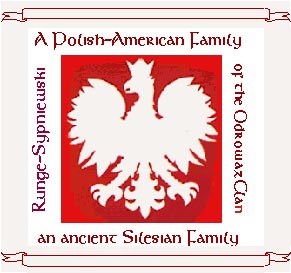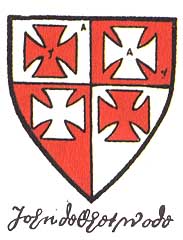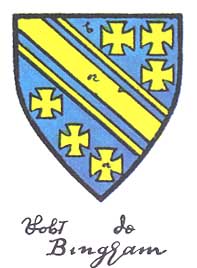

Arms Bearing the Cross Patée
The cross represents spatial orientation, the intersection of vertical and horizontal axes. The cross on which Jesus was crucified was probably a tau cross (St. Anthony's cross), formed like the letter "T." Thor's hammer is in a cross shaped, and was a popular Germanic amulet. The Egyptian cross or ankh is their cross of life. It is crowned with a circle or oval. The ankh is often held by Pharoahs. The Egyptian Christians (Copts) placed an ankh on gravestones.
The main subject of this writing is the cross patée.
In the Chronicles of the Crusaders, it states that the Comte de Jaffa, cousin to the Lord Montbeliard and the house of Joinville had a large gallery ship painted with escutcheons bearing his arms, which were or (gold) cross patée. His galley had at least three hundred rowers. Each shield was attached with a pennon (flag) with the same arms worked in gold (Joinville, 203). The multiple flags made quite a display as the ship was rowed into port, as the breeze rippled them in mass. This event was witnessed in 1249, while the ship was landing in Egypt.
This sighting was made by Jean de Joinville and was recorded in his journal: "The Life of Saint Louis." Jean de Joinville was born berween 1224 and 1225, and was the second son of a nobleman of Champayne, France. Joinville took the cross in 1246, which was the Seventh Crusade led by Louis of France.
SOURCES:
Foss, Michael. People of the First Crusade. New York: Arcade Publishing, 1997.
Foster, Joseph. The Dictionary of Heraldry: Fuedal Coats of Arms and Pedigrees. London: Studio Editions Ltd., 1994 (reprinted from the black and white Some Feudal Coats of Arms published in 1902 by James Parker and Company).
Fox-Davies, A.C. A Complete Guide to Heraldry. London: Bonanza Books, 1969, 100, 153.
Paszkiewicz, Nieczyslaw and Jerzy Kulczycki. Herby Rodow Polskich. London: Orbis Books, Ltd., 1990 (reprint of various books including Zbigniew Leszczyc's Herby Szlanchty Polskiej.
Woodcock, Thomas. The Oxford Guide to Heraldry. Oxford: Oxford University Press, 1988.
This page was last updated on June 20, 2005
Written and Researched by Margaret Sypniewska
In heraldry there are crosses in many forms:

bore, quarterly argent and gules,
four crosses patée counterchanged;
Shirley. This is arms is of Norman -
French origin
and Robert de Bingham of Melcombe,
Somerset, England. bore, azure, a
bend cotised between six crosses patée or.
--Shirley. This arms is of Norman -
French origin.
View My Guestbook
Sign My Guestbook
visitor since July 18, 2003
Owner: Raymond Sypniewski, B.S., M.A., PNA.
Email Margaret:
Margaret
